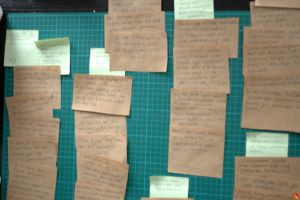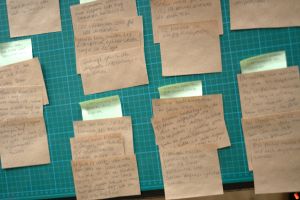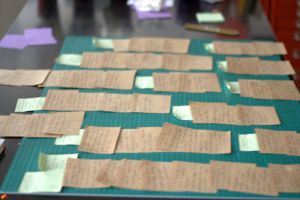Human Centered Design Research - Documentation
Design Goal
Our goal is to make the process of finding CC-licensed works quicker and more efficient for our target audience "professional creatives".
Research
For our interviews we developed the following questions as a central theme, but we often changed the questions depending on the interview partner.
- Have you already dealt with the subject of licenses and to what extent does this subject concern you? (maybe ask about last project)
- What do you know about Creative Commons? Have you maybe seen the Logo somewhere?
- Have you already used CC somewhere? Do you use it regularly? Do you inform your clients about it?
- What's your opinion on the usability of CC?
- Would you publish one of your projects under a CC License?
- Overall impression, possible improvements?
Analysis
Through the analysis we did after our interviews we extracted the following assumptions.
- CC is easy to handle because of the license creator and the fine differentiation between the licenses
- users wish for a better representation of the licenses in symbol form, becaue the current symbols aren't self-explanatory and are hard to understand without further explanation at first
- users wish for direct granting of a license on the file
- creatives don't want their works to be commercially used further on
- most common reasons for using a CC-license is for house advertising, not so much for using a work for client projects
- CC-licenses are respected, works get appreciated because of CC-licenses
- granting of a license and use need a control mechanism
- artists upload their works only on communities/platforms like Flickr
- the handling of licenses in communities (e.g. Flickr, DeviantART) is easy, especially the design and filter possibilities are important there
- CC means give-and-take, instead of commercial use of creative works, creative varity and insparation are of utter importance
- CC-licensed material offers barely qualitative works due to hobby use and reuse of licenses
- CC-words are partly very specific artistic material which is not reuseable for agencies
- commercial stock photo agencies are still favoured, becaue the handling is clear and efficient, also the guarantee due to the presence of an agency and their transparent price policy are important as well
- there is also ignorance and indifference about licenses among professional creatives
Below are a few pictures of our analysis.
Our first Idea
Our idea is to build an online archive with only CC-licensed stock. A specialized filter-function would provide an easier and faster search. We had research-filters like licenses, themes and colors in mind. An important new function should be a specialized tagging and labeling method for the CC-licenses material. It should be easy, clear and not attract too much attention when in use. Therefore we would like to find a way to hide the labeling of the work, for example by the use of a meta level.
Here is a rough wire frame of the design we imagine for the archive: File:WireframeCCArchive MyFile.pdf
Our second Idea
Brainstorm:
inspiration - Collage - collecting ideas - Intuition - surprising - innovative - nouveau - artistic - open - inspiring - bulletin board - interest wall
Idea: "CC-inspiration wall"
The "CC - inspiration wall" idea is built on our Archive idea, but without the importance of the search functions. It is more like a community where people can share ideas, follow other users and put together their own "inspiration wall".
Purpose of the side is to generate a way of sharing for fun and artistic inspiration, without any commercial intention. This is because our research showed that many cc-users weren't comfortable with their work being published for commercial use. But on the other hand they liked the idea of the creative output, that cc-based work could give them. The fact that many artists and other creatives are already using cc-licenses to label their work is because they would use cc-licenses to publish their own work in order to get their own publicity. It is more like the idea of seeing and being seen.
This would also be interesting for creative agencies and freelancers to build up their own walls to publish their works or share and like others, to compose an profile, so people can see their creative focus.
Scenario 1 - CC-Archive
Ich bin ein selbständiger Grafiker, sehr stark im Privatbereich tätig. Gerade habe ich einen Auftrag für ein Corporate Design für einen gemeinnützigen Verein erhalten. Die Herausforderung bei diesem Auftrag ist das geringe Budget. Ich überlege, einen stark fotolastigen Flyer zu gestalten und begebe mich auf die Recherche im Internet. Im Hinterkopf habe ich die Creative Commons Lizenzen, die sich für diesen Auftrag anbieten würden. Auf meiner Suche entdecke ich ziemlich schnell eine neue Seite auf der ich viele Creative Commons Inhalte finde. Sofort benutze ich die Suchfunktionen der Seite, die sehr viele unterschiedliche und gut strukturierte Filterfunktionen bietet. Ich suche ausschließlich Bilder in guter Druckqualität und dem Thema Wasser und Schwimmen. Hier kann ich im Filter angeben, dass ich Bilder mit einer hohen Auflösung und einem geeignetem Dateityp suche. Außerdem kann ich zusätzlich das Thema, nachdem ich suche, eingeben. Also tippe ich Schwimmen ins Suchfeld und die Suchmaschine zeigt mir ausschließlich Resultate mit den von mir gewünschten Eigenschaften. Ich scrolle durch die Bilder und suche mir Motive, die zu meiner Gestaltung passen aus. Ich klicke ein entsprechendes Bild an undgelange auf eine Unterseite mit dem Bild und Informationen zum Bild. Hier kann ich die Lizenzbedingungen ersehen und das Bild herunterladen. Unter der Bildbeschreibung entdecke ich Kommentare anderer Nutzer, die das Bild sehr positiv bewerten Einer von Ihnen schreibt "Sehr gute Druckqualität, habe das Bild selber schon für einen Flyer benutzt." Daraufhin, ermutigt in meiner Entscheidung, klicke ich auf den Download-Button neben dem Bild. Nun landet das Bild in meinem Downloadordner und ich stelle fest, dass eine weitere Datei mit heruntergeladen wurde, in der ich die Lizenzbedingungen finde. Das finde ich sehr praktisch, da ich dort auch den Link zur Seite, auf der ich das Bild heruntergeladen habe, finde. So erspare ich mir einen Lesezeichenwust im Browserfenster und habe Quelle und Bild immer zusammen abgespeichert. So kann ich die Referenz aus der Datei kopieren und ganz klein auf dem Flyer vermerken. Meine Kunden sind sehr zufrieden mit der Creative Commons Lösung und stören sich auch nicht an der Referenzangabe. So kann der Flyer, rechtlich abgesichert, in den Druck gehen.


